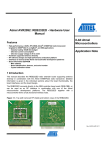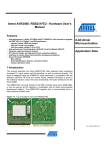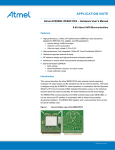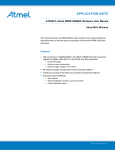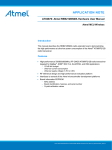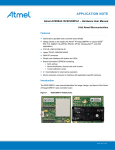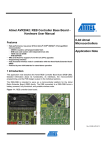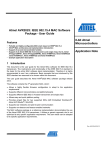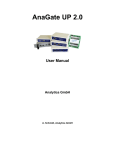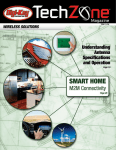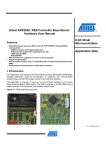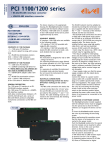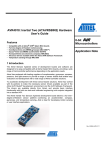Download Atmel AVR2043: REB231ED - Hardware User manual 8
Transcript
Atmel AVR2043: REB231ED - Hardware User manual Features • High-performance, 2.4GHz, RF-CMOS AT86RF231 radio transceiver targeted for IEEE® 802.15.4, ZigBee®, and ISM applications - Industry leading 104dB link budget - Ultra-low current consumption - Ultra-low supply voltage (1.8V to 3.6V) • Hardware supported antenna diversity • RF reference design and high-performance evaluation platform • Interfaces to several of Atmel’s microcontroller development platforms • Board information EEPROM - MAC address - Board identification, features, and serial number - Crystal calibration values 8-bit Atmel Microcontrollers Hardware User Manual 1 Introduction This manual describes the REB231ED radio extender board supporting antenna diversity in combination with the Atmel® AT86RF231 radio transceiver. Detailed information is given in the individual sections about the board functionality, the board interfaces, and the board design. The REB231ED connects directly to the REB controller base board (REB-CBB), or can be used as an RF interface in combination with one of Atmel’s microcontroller development platforms. The REB231ED together with a microcontroller forms a fully functional wireless node. Figure 1-1. Top and bottom views of the REB231ED. Rev. 8345A-AVR-05/11 2 Disclaimer Typical values contained in this application note are based on simulations and testing of individual examples. Any information about third-party materials or parts was included in this document for convenience. The vendor may have changed the information that has been published. Check the individual vendor information for the latest changes. 3 Overview The radio extender board is assembled with an Atmel AT86RF231 radio transceiver [1] and two ceramic antennas, and demonstrates the unrivaled hardware-based antenna diversity feature, which significantly improves radio link robustness in harsh environments. The radio extender board was designed to interface to Atmel’s microcontroller development or evolution platforms. The microcontroller platform in combination with the REB provides an ideal way to: • Evaluate the outstanding radio transceiver performance, such as the excellent receiver sensitivity achieved at ultra-low current consumption • Test the radio transceiver’s comprehensive hardware support of the IEEE 802.15.4 standard • Test the radio transceiver’s enhanced feature set, which includes antenna diversity, AES, high data rate modes and other functions The photograph in Figure 3-1 shows a development and evaluation setup using the REB controller base board [2] in combination with the REB231ED radio extender board. Figure 3-1. The REB231ED connected to an REB-CBB. 2 Atmel AVR2043 8345A-AVR-05/11 Atmel AVR2043 4 Functional description The block diagram of the REB231ED radio extender board is shown in Figure 4-1. The power supply pins and all digital I/Os of the radio transceiver are routed to the 2 x 20-pin expansion connector to interface to a power supply and a microcontroller. The Atmel AT86RF231 antenna diversity (AD) feature supports the control of two antennas (ANT0/ANT1). A digital control pin (DIG1) is used to control an external RF switch selecting one of the two antennas. During the RX listening period, the radio transceiver switches between the two antennas autonomously, without the need for microcontroller interaction, if the AD algorithm is enabled. Once an IEEE 802.15.4 synchronization header is detected, an antenna providing sufficient signal quality is selected to receive the remaining frame. This ensures reliability and robustness, especially in harsh environments with strong multipath fading effects. Board-specific information such as board identifier, the node MAC address, and production calibration values are stored in an ID EEPROM. The SPI bus of the EEPROM is shared with the radio transceiver’s interface. Figure 4-1. REB231ED block diagram. 4.1 Interface connector specification The REB is equipped with a 2 x 20-pin, 100mil expansion connector. The pin assignment enables a direct interface to the REB-CBB [2]. Further, the interface connects to the Atmel STK500/501 microcontroller development platform to enable support for various Atmel 8-bit AVR® microcontrollers. The REB is preconfigured to interface to an STK501 with an Atmel ATmega1281. If an Atmel ATmega644 is used as the microcontroller, the 0Ω resistors R10 through R18 must be removed and re-installed on the board manually as resistors R20 through R28 (see Exhibit A.1). Other microcontroller development platforms need to be interfaced using a special adapter board. 3 8345A-AVR-05/11 4.1.1 ATmega1281 configuration Table 4-1. Default expansion connector mapping (ATmega1281 configuration). Pin# Function Pin# Function 1 GND 2 GND 3 n.c. 4 n.c. 5 n.c. 6 n.c. 7 n.c. 8 n.c. 9 n.c. 10 n.c. 11 n.c. 12 n.c. 13 n.c. 14 n.c. 15 n.c. 16 n.c. 17 XT1 (MCLK) 18 n.c. 19 Vcc 20 Vcc 21 GND 22 GND 23 PB7 (open) 24 PB6 (open) 25 PB5 (RSTN) 26 PB4 (SLPTR) 27 PB3 (MISO) 28 PB2 (MOSI) 29 PB1 (SCLK) 30 PB0 (SEL) 31 PD7 (TP1) 32 PD6 (MCLK) 33 PD5 (TP2) 34 PD4 (DIG2) 35 PD3 (TP3) 36 PD2 (open) 37 PD1 (TP4) 38 PD0 (IRQ) 39 GND 40 EE#WP (write protect EEPROM) 4.1.2 ATmega644 configuration Table 4-2. Expansion connector mapping when assembled for ATmega644. 4 Pin# Function Pin# Function 1 GND 2 GND 3 n.c. 4 n.c. 5 n.c. 6 n.c. 7 n.c. 8 n.c. 9 n.c. 10 n.c. 11 n.c. 12 n.c. 13 n.c. 14 n.c. 15 n.c. 16 n.c. 17 XT1 (MCLK) 18 n.c. 19 Vcc 20 Vcc 21 GND 22 GND 23 PB7 (SCLK) 24 PB6 (MISO) 25 PB5 (MOSI) 26 PB4 (SEL) Atmel AVR2043 8345A-AVR-05/11 Atmel AVR2043 Pin# Function Pin# Function 27 PB3 (open) 28 PB2 (RSTN) 29 PB1 (MCLK) 30 PB0 (open) 31 PD7 (SLPTR) 32 PD6 (DIG2) 33 PD5 (TP2) 34 PD4 (open) 35 PD3 (TP3) 36 PD2 (IRQ) 37 PD1 (TP4) 38 PD0 (open) 39 GND 40 EE#WP (write protect EEPROM) 4.2 ID EEPROM To identify the board type by software, an optional identification (ID) EEPROM is populated. Information about the board, the node MAC address, and production calibration values are stored here. An Atmel AT25010A [8] with 128 x 8-bit organization and SPI bus is used because of its small package and low-voltage / lowpower operation. The SPI bus is shared between the EEPROM and the transceiver. The select signal for each SPI slave (EEPROM, radio transceiver) is decoded with the reset line of the transceiver, RSTN. Therefore, the EEPROM is addressed when the radio transceiver is held in reset (RSTN = 0) (see Figure 4-2). Figure 4-2. EEPROM access decoding logic (ATmega1281 configuration). PB5 (RSTN) PB0 (SEL) RSTN SEL# >1 PB1..3 (SPI) /RST /SEL Transceiver AT86RF231 SPI >1 #CS On-Board EEPROM The EEPROM data is written during board production testing. A unique serial number, the MAC address1, and calibration values are stored. These can be used to optimize system performance. Final products do not require this external ID EEPROM. All data can be stored directly within the microcontroller’s internal EEPROM. Table 4-3 shows a detailed description of the EEPROM data structure. Table 4-3. ID EEPROM mapping. Address Name Type Description 0x00 MAC address uint64 MAC address for the 802.15.4 node, little endian byte order 0x08 Serial number uint64 Board serial number, little endian byte order 1 Note: MAC addresses used for this package are Atmel property. The use of these MAC addresses for development purposes is permitted. 5 8345A-AVR-05/11 Address Name Type Description 0x10 Board family uint8 Internal board family identifier 0x11 Revision uint8[3] Board revision number ##.##.## 0x14 Feature uint8 Board features, coded into seven bits 7 Reserved 6 Reserved 5 External LNA 4 External PA 3 Reserved 2 Diversity 1 Antenna 0 SMA connector 0x15 Cal OSC 16MHz uint8 RF231 XTAL calibration value, register XTAL_TRIM 0x16 Cal RC 3.6V uint8 Atmel ATmega1281 internal RC oscillator calibration value @ 3.6V, register OSCCAL 0x17 Cal RC 2.0V uint8 Atmel ATmega1281 internal RC oscillator calibration value @ 2.0V, register OSCCAL 0x18 Antenna gain Int8 0x20 Board name char[30] Textual board description 0x3E CRC uint16 Antenna gain [resolution 1/10dBi]. For example, 15 will indicate a gain of 1.5dBi. The values 00h and FFh are per definition invalid. Zero or -0.1dBi has to be indicated as 01h or FEh 16-bit CRC checksum, standard ITU-T generator polynomial 16 12 5 G16(x) = x + x + x + 1 Figure 4-3. Example EEPROM dump. -----| EEPROM dump |-------------0000 - 49 41 17 FF FF 25 04 00 D6 11 00 00 2A 00 00 00 IA...%......*... 0010 - 02 04 01 01 06 02 A8 A9 01 FF FF FF FF FF FF FF ................ 0020 - 52 61 64 69 6F 45 78 74 65 6E 64 65 72 32 33 31 RadioExtender231 0030 - 45 44 00 00 00 00 00 00 00 00 00 00 00 00 8D 9B ED.............. 0040 - FF FF FF FF FF FF FF FF FF FF FF FF FF FF FF FF ................ 0050 - FF FF FF FF FF FF FF FF FF FF FF FF FF FF FF FF ................ 0060 - FF FF FF FF FF FF FF FF FF FF FF FF FF FF FF FF ................ 0070 - FF FF FF FF FF FF FF FF FF FF FF FF FF FF FF FF ................ ---------------------------------- 4.3 Supply current sensing The power supply pins of the radio transceiver are protected against overvoltage stress and reverse polarity at the EXPAND1 pins (net CVTG, net DGND) using a Zener diode (D1) and a thermal fuse (F1) (see Exhibit A.1). This is required because the Atmel STK500 will provide 5V as default voltage, and the board can also be mounted with reverse polarity. 6 Atmel AVR2043 8345A-AVR-05/11 Atmel AVR2043 Depending on the actual supply voltage, the diode D1 can consume several milliamperes. This has to be considered when the current consumption of the whole system is measured. In such a case, D1 should be removed from the board. To achieve the best RF performance, the analog (EVDD, AGND) and digital (DEVDD, DGND) supply are separated from each other by a CLC PI-element. Digital and analog ground planes are connected together on the bottom layer, underneath the radio transceiver IC. Further details are described in Section 5, page 9. A jumper, JP1, is placed in the supply voltage trace to offer an easy way for current sensing to occur. NOTE All components connected to nets DEVDD/EVDD contribute to the total current consumption. While in radio transceiver SLEEP state, most of the supply current is drawn by the 1MΩ pull-up resistor, R9, connected to the ID EEPROM and the EEPROM standby current. Figure 4-4. Power supply routing. 4.4 Radio transceiver reference clock The integrated radio transceiver is clocked by a 16MHz reference crystal. The 2.4GHz modulated signal is derived from this clock. Operating the node according to IEEE 802.15.4 [4], the reference frequency must not exceed a deviation of ±40ppm. The absolute frequency is mainly determined by the external load capacitance of the crystal, which depends on the crystal type and is given in its datasheet. The radio transceiver reference crystal, Q1, shall be isolated from fast switching digital signals and surrounded by a grounded guard trace to minimize disturbances of the oscillation. Detailed layout considerations can be found in Section 5.3, page 11. The REB uses a Siward CX4025 crystal with load capacitors of 10pF and 12pF. The imbalance between the load capacitors was chosen to be as close as possible to the desired resonance frequency with standard components. To compensate for fabrication and environment variations, the frequency can be further tuned using the radio transceiver register XOSC_CTRL (0x12) (refer to [1], Section References, page 30). The REB production test guarantees a tolerance of within +20ppm and -5ppm. The correction value, to be applied to TRX register XOSC_CTRL (0x12), is stored in the onboard EEPROM (see Section 4.2, page 5). The reference frequency is also available at pin CLKM of the radio transceiver and, depending on the related register setting, it is divided by an internal prescaler. CLKM clock frequencies of 16MHz, 8MHz, 4MHz, 2MHz, 1MHz, 250kHz, or 62.5kHz are programmable (refer to [1]). The CLKM signal is filtered by a low-pass filter to reduce harmonic emissions within the 2.4GHz ISM band. The filter is designed to provide a stable 1MHz clock signal with correct logic level to a microcontroller pin with sufficiently suppressed harmonics. CLKM frequencies above 1MHz require a 7 8345A-AVR-05/11 redesign of R8 and C36. In case of RC cut-off frequency adjustments, depending on the specific load and signal routing conditions, one may observe performance degradation of channel 26. NOTE Channel 26 (2480MHz) is affected by the following harmonics: 155 x 16MHz or 310 x 8MHz. By default, CLKM is routed to a microcontroller timer input; check the individual configuration resistors in the schematic drawing. To connect CLKM to the microcontroller main clock input, assemble R3 with a 0Ω resistor. 4.5 RF section The Atmel AT86RF231 radio transceiver incorporates all RF and BB critical components necessary to transmit and receive signals according to IEEE 802.15.4 or proprietary ISM data rates. A balun, B1, performs the differential to single-ended conversion of the RF signal to connect the Atmel AT86RF231 to the RF switch, U1. The RF switch is controlled by the radio transceiver output, DIG1, and selects one of the two antennas. The signal is routed to the ceramic antenna, passing a tuning line. Solder pads located along the tuning line allow for the optimization of antenna matching without the need for redesigning the REB. Detailed information about the antenna diversity feature is given in [1] and [3]. Optionally, one or two SMA connectors can be assembled if conducted measurements are to be performed. Refer to the schematic and populate coupling capacitors C11/C12 and C18/C19 accordingly. 8 Atmel AVR2043 8345A-AVR-05/11 Atmel AVR2043 5 PCB Layout Description This section describes critical layout details to be carefully considered during a PCB design. The PCB design requires an optimal solution for the following topics: • Create a solid ground plane for the antenna. The PCB has to be considered as a part of the antenna; it interacts with the radiated electromagnetic wave. • Isolate digital noise from the antenna and the radio transceiver to achieve optimum range and RF performance. • Isolate digital noise from the 16MHz reference crystal to achieve optimum transmitter and receiver performance. • Reduce any kind of spurious emissions below the limits set by the individual regulatory organizations. The REB231ED PCB design further demonstrates a low-cost, two-layer PCB solution without the need of an inner ground plane. The drawing in Figure 5-1 shows critical sections using numbered captions. Each caption number has its own subsection below with detailed information. Figure 5-1. Board layout – RF section. 9 8345A-AVR-05/11 5.1 PCB detail 1 – balanced RF pin fan out Figure 5-2. Board layout – RF pin fan out. The Atmel AT86RF231 antenna port should be connected to a 100Ω load with a small series inductance of 1nH to 2nH. This is achieved with the connection fan out in between the IC pins and the DC blocking capacitors, C26 and C27. The trace width is kept small at 0.2mm for a length of approximately 1.5mm. The REB231ED is a twolayer FR4 board with a thickness of 1.5mm. Therefore, the distributed capacitance between top and bottom is low, and transmission lines are rather inductive. 10 Atmel AVR2043 8345A-AVR-05/11 Atmel AVR2043 5.2 PCB detail 2 – RF switch Figure 5-3. Board layout – RF switch. The RF switch requires a solid grounding and RF filter capacitors for the control pins. A parasitic inductance may reduce the RF isolation of the switch in the off state. To achieve a hard, low-impedance ground connection, a via is placed on each side of the ground pad. Additionally, the ground pad is connected to the top layer ground plane. Blocking capacitors C38 and C39 are placed as close as possible to the RF switch to short any control line noise, avoiding parasitic amplitude modulation of the RF signal. 5.3 PCB detail 3 – crystal routing The reference crystal PCB area requires optimization to minimize external interference and to keep any radiation of 16MHz harmonics low. 11 8345A-AVR-05/11 Figure 5-4. Board layout – XTAL section. The reference crystal and load capacitors C34/35 form the resonator circuit. These capacitors are to be placed close to the crystal. The ground connection in between the capacitors should be the crystal housing contact, if available, resulting in a compact, robust and stable resonator. The resonator block is enclosed within ground traces around it and a plane on the bottom side. Do not connect the resonator directly to the plane beneath the block. The only ground connection for the resonator block should be a trace in parallel with the two crystal lines that connects to TRX pin 27 or the paddle. Based on recent experiments, the bottom ground connection shall be routed directly to the paddle or pin 27. The loop is not required. In addition, the open space underneath the crystal can be filled with copper. A small keep out trace next to the 12 Atmel AVR2043 8345A-AVR-05/11 Atmel AVR2043 bottom ground connection can help to keep this connection separate and prevent the layout tool from flooding across this trace. When designing applications for very harsh environments, for example where the radio transceiver is close to mains power lines and burst and surge requirements already dictate special provisions in the design, the above reference crystal design might not work well. In this case, the reference crystal ground is to be directly connected to top and bottom layers. 5.4 PCB – analog GND routing With the Atmel AT86RF231, consider pins 3, 6, 27, 30, 31, and 32 as analog ground pins. Analog ground pins are to be routed to the paddle underneath the IC. The trace width has to be similar to the pad width when connecting the pads, and increase, if possible, some distance from the pad. Figure 5-5. Board layout – transceiver GND. Each ground pin should be connected to the bottom plane with at least one via. Move the vias as close to the IC as possible. It is always desired to integrate the single-pin ground connections into polygon structures after a short distance. Top, bottom, and, on multilayer boards, the inner ground planes, should be tied together with a grid of vias. When ground loops are smaller than one tenth of the wavelength, it is safe to consider this as a solid piece of metal. The soldering technology used allows the placement of small vias (0.15mm drill) within the ground paddle underneath the chip. During reflow soldering, the vias get filled with solder, having a positive effect on the connection cross section. The small drill size keeps solder losses within an acceptable limit. Vias should be open on the bottom side to allow enclosed air to expand during the soldering process. 13 8345A-AVR-05/11 5.5 PCB – digital GND routing With the Atmel AT86RF231, consider pins 7, 12, 16, 18, and 21 as digital ground pins. Digital ground pins are not directly connected to the paddle. Digital ground pins may carry digital noise from I/O pad cells or other digital processing units within the chip. In case of a direct paddle connection, impedances of the paddle ground vias could cause a small voltage drop for this noise and may result in an increased noise level transferred to the analog domain. 5.6 PCB – GND plane Besides the function to provide supply ground to the individual parts, the ground plane has to be considered as a counterpart for the antenna. Such an antenna base plate is considered a continuous metal plane. For that reason, any unused surface should be filled with a copper plane and connected to the other ground side using sufficient through holes. Larger copper areas should also be connected to the other side layer with a grid of vias. This way, for an external EM field, the board will behave like a coherent piece of metal. When a trace is cutting the plane on one side, the design should contain vias along this trace to bridge the interrupted ground on the other side. Place vias especially close to corners and necks to connect lose polygon ends. 5.7 Ceramic antenna 5.7.1 Antenna design study Part of the diversity board development was the evaluation of the antenna setup. A dedicated board was designed to determine the key design parameters for a diversity antenna configuration. Because the antenna has to operate in an environment different from that of the manufacturer’s evaluation board, the correct frequency tuning has to be verified. The antenna distance, required for optimum diversity operation, provides enough board space to use a low-cost tuning method based on a transmission line and capacitors. The actual tuning procedure is explained in Section 5.7.3, page 18. 14 Atmel AVR2043 8345A-AVR-05/11 Atmel AVR2043 Figure 5-6. Initial antenna tuning and test board. Besides the antenna tuning, the test board was used to measure the diversity effect and the coupling between the two antennas. The better the two antennas are isolated from each other, the higher is the diversity advantage for the receiver. It has to be considered that the unused antenna is operating against an open line end because the RF switch, U1, has high impedance in the off position. A low coupling in between the antennas is therefore required. Direct coupling measurement results between both antennas are shown in Figure 5-7, page 16. Over the operating frequency range, the antenna separation is >15dB. That is achieved mainly with the ±45-degree installation. The 90-degree turn between left and right antennas causes orthogonal radiation patterns and minimal coupling. Because the polarization of a received wave is not deterministic in a multipath environment, this setup is also capable of selecting the optimum polarization match for an incoming wave. The other design aspect is the antenna distance. The antenna distance has to be large enough to ensure only one of the two antennas is present in a local fading minimum. Figure 5-8, page 17, shows the field strength plot for both antennas, dependent on the board position. For this test, the antenna board was moved along a workbench using a stepper motor. The transmitter was positioned several meters away on another workbench. No direct line of sight connection is ensured using a large metal plate. The graph shows receive signal strength variations caused by the interference of reflected waves reaching the receiver via different propagation paths. 15 8345A-AVR-05/11 From Figure 5-8, page 17, one can conclude key parameters for such an indoor scenario: 1. For one antenna, multipath fades can exceed 30dB 2. For the 2.4GHz ISM band, a local fading minimum is typically below 5cm (~2in). This number is expected considering the wavelength. Conclusion: an antenna diversity design should place antennas at a distance larger than that. 3. For almost all positions, only one antenna is in a deep fade. The setup prepared for this test demonstrates the advantage of using antenna diversity. Figure 5-7. Coupling between left and right antennas. If practical situations are further analyzed (see Figure 5-8, page 17), one can derive a practical “antenna gain” for the diversity setups. To ensure robust and reliable communication, a single antenna system has to consider at least a 30dB link margin as fade margin. Considering the multipath setup used for the experiment, a signal level of -70dBm is the worst case receiver signal strength when operating on antenna diversity. A single antenna system could get into a spot where the receive power is as low as -85dBm. It might be too optimistic in an indoor environment to take the 15dB and state that an antenna diversity system has four times the range compared to a non-antenna diversity system. But antenna diversity cuts deep fades and strongly increases the stability of a radio link. This is essential for radio nodes that get installed in a fixed position, as with wall mounted equipment. The location of deep fades can move over time due to small changes inside the room or building as there are doors, windows, furniture, and people that may move. 16 Atmel AVR2043 8345A-AVR-05/11 Atmel AVR2043 Figure 5-8. Local fading effects in an indoor multipath environment. 5.7.2 Antenna design-in This section describes the antenna design-in detail, and the implementation of the antenna tuning structure. An overview of the layout can be found in Figure 5-9. Figure 5-9. Antenna PCB environment and tuning structure. 17 8345A-AVR-05/11 The antenna is available from two sources: 1. Johanson 2450AT45A100 2. Würth 7488910245 The antenna test board, as specified by the manufacturers, has a ground plane size of 20mm x 40mm, an antenna placed in a 12mm x 20mm FR4 area, and an FR4 substrate height of 0.8mm. This is the expected environment where the antenna performance should be equivalent to the datasheet values. On the REB231ED, the environment differs considerably because the FR4 height is 1.5mm, the antenna is placed in a triangular corner and the ground plane geometry is different, too. To compensate for the larger substrate height, a 2mm not-plated drill hole is placed underneath the antenna ceramic core (see Figure 5-9, detail 1). The PCB ground is designed with a 45 degree angle along the red line (Figure 5-9, detail 2), forming an optimum antenna ground reference. The antenna tuning requires two more elements, a series capacitor at the antenna feed point (Figure 5-9, detail 3) and a capacitor that can be moved in position along the feed line (Figure 5-9, detail 4). The series capacitor must be placed at the antenna feed point. Under normal conditions, only one capacitor is required within the detail 4 section of the PCB. By choosing the correct footprint, the capacitor can be moved along the line. The impedance transformation across the transmission line depends on the distance between the antenna feed point and the capacitor in detail 4, resulting in the tuning effect. The tuning procedure is explained in Section 5.7.3. 5.7.3 Antenna tuning The first step for the measurements is a board rework to access the RF line with a 50Ω coaxial cable. In the case of the REB231ED, the balun, B1, was removed and a small, rigid 50Ω cable with an SMA connector was connected to the balun pin 1 pad. The ground planes next to this feed point where used to create a solid ground connection for this cable. This feed point will allow the measurement of both antennas because of the on-board RF switch. The RF switch was controlled by applying the correct voltage levels from a lab power supply. 18 Atmel AVR2043 8345A-AVR-05/11 Atmel AVR2043 Figure 5-10. Antenna feed line short for extended length calibration. The second step is to calibrate the network analyzer (NWA) to the 50Ω connector as usual. After normal calibration, the reference point for the NWA is at the cable SMA connection. To determine the tuning elements, the reference point has to be moved to the antenna feed point using the extended length parameter inside the NWA. To determine this parameter, a hard short is required at the antenna feed line end. Remove the solder resist on the left and right sides of the feed line end and short the line end to ground with two solder bumps (see Figure 5-10, page 19). Do not use any wires to create a ground connection. The calibration procedure will only work when the short is exactly at the line end and has a minimum of parasitic inductance. Now the NWA extended length parameter can be adjusted until the NWA’s Smith chart displays a nice short for the desired frequency range. In the third step, the antenna behavior can be measured without any tuning elements. To see the real antenna behavior, the board must be placed in a position similar that of the final application. If the final application has a housing installed, then all these measurements must be done with the housing attached. Any piece of metal or plastic can tune the antenna to a different frequency. In the case of small boards with an edge length of less than 10cm, the connected RF cable is often a source of measurement errors. The outer conductor of the coaxial cable could interact with the field radiated by the antenna and, therefore, create an additional counterpart ground for the antenna. To avoid this effect, the coaxial cable can be fed through several ferrite beads. The ferrite beads need to be placed close to the test board. The initial measurement shows that the antenna is already working nicely in the desired frequency band. The feed resistance is a bit low, and the antenna has an inductive behavior. 19 8345A-AVR-05/11 Figure 5-11. Antenna without tuning elements. The first tuning step will use the series capacitor to tune the band center down to a pure resistive behavior. The band center is crossing the 30 degree (1/3 x Z0) line. Therefore, the tuning capacitor can be determined by: C= 1 2πfXc with 1 Xc = * 50Ohm 3 f = 2.450GHz We get a capacitance of 3.89pF, and can simply use a 3.9pF value. The result of this tuning step can be seen in Figure 5-12, page 21. 20 Atmel AVR2043 8345A-AVR-05/11 Atmel AVR2043 Figure 5-12. Antenna tuning with series capacitor. The final tuning step will use a shunt capacitor to correct the antenna load impedance. A 0.5pF capacitor has been used to tune the antenna resonance frequency to the band center. If the antenna resonance frequency is too low, the capacitor needs to be moved towards the antenna, and vice versa. Figure 5-13. Final tuning. 21 8345A-AVR-05/11 Figure 5-13, page 21, and Figure 5-14 show the final result as a diagram and on the board. Figure 5-14. Antenna tuning with series and shunt capacitor. In most cases, it is beneficial to tune the antenna a little towards higher frequencies. The reason is that environmental changes in most cases tune the antenna down to lower frequencies. Such environmental changes can be any kind of object that is situated near the antenna, such as a housing or table surface. The tuning determined in this example is only valid for the antenna example board. The REB231ED, with its different ground plane design and many more differences, may have other parts assembled. 22 Atmel AVR2043 8345A-AVR-05/11 Atmel AVR2043 6 Mechanical description The REB231ED is manufactured using a low-cost, two-layer printed circuit board. All components and connectors are mounted on the top side of the board. The format was defined to fit the EXPAND1 connector on the Atmel AVR STK500 / STK501 microcontroller evaluation board. The upright position was chosen for best antenna performance. Figure 6-1. Mechanical outline (dimensions in mm). Table 6-1. REB231ED mechanical dimensions. Dimension Value Width x 57mm Width y 57mm 23 8345A-AVR-05/11 7 Electrical characteristics 7.1 Absolute maximum ratings Stresses beyond those listed under “Absolute Maximum Ratings” may cause permanent damage to the board. This is a stress rating only, and functional operation of the device at these or any other conditions beyond those indicated in the operational sections of this manual are not implied. Exposure to absolute maximum rating conditions for extended periods may affect device reliability. For more details about these parameters, refer to individual datasheets of the components used. Table 7-1. Absolute maximum ratings. No. Parameter Condition 7.1.1 Storage temperature range 7.1.2 Humidity 7.1.3 Minimum Typical Maximum Units -40 +85 °C 90 % Supply voltage -0.3 +3.6 V 7.1.4 EXT I/O pin voltage -0.3 Vcc + 0.3 V 7.1.5 Supply current from batteries -0.5 A 7.1.6 Note: Battery charge current Non-condensing Sum over all power pins (1) 0 mA 1. Keep power switch off or remove battery from REB-CBB when external power is supplied. 7.2 Recommended operating range Table 7-2. Recommended operating range. No. Parameter 7.2.1 Operating temperature range 7.2.2 7.2.3 Supply voltage (Vcc) 7.2.4 Condition Minimum Typical -20 Maximum Units +70 °C Plain REB-CBB 1.6 3.0 3.6 V REB plugged on REB-CBB 1.8 3.0 3.6 V Serial flash access in usage 2.3 3.0 3.6 V 7.3 Current consumption Test conditions (unless otherwise stated): VDD = 3.0V, TOP = 25°C Table 7-3 lists current consumption values for typical scenarios of a complete system composed of REB-CBB and REB231. The Zener diode has been removed as described above. Table 7-3. Current consumption of REB-CBB populated with REB231. No. Parameter Condition 7.3.1 Supply current MCU @ power down, transceiver in state SLEEP, serial flash in Deep-Sleep 17 µA 7.3.2 Supply current MCU @ 2MHz, transceiver in state TRX_OFF 3 mA 7.3.3 Supply current MCU @ 16MHz (int. RC 32MHz), transceiver in state TRX_OFF 15 mA 24 Minimum Typical Maximum Units Atmel AVR2043 8345A-AVR-05/11 Atmel AVR2043 No. Parameter Condition Minimum Typical Maximum Units 7.3.4 Supply current MCU @ 16MHz (int. RC 32MHz), transceiver in state TRX_ON 28 mA 7.3.5 Supply current MCU @ 16MHz (int. RC 32MHz), transceiver in state BUSY_TX 26 mA 8 Abbreviations BB - Baseband REB-CBB - REB controller base board NWA - Network analyzer PDI - Program/debug interface REB - Radio extender board RF - Radio frequency SPI - Serial peripheral interface XOSC - Crystal oscillator XTAL - Crystal 25 8345A-AVR-05/11 Appendix A - PCB design data A.1 Schematic 26 Atmel AVR2043 8345A-AVR-05/11 Atmel AVR2043 A.2 Assembly drawing Figure 8-1. REB231ED assembly drawing A2 C C 2 1 A1 5 9 C C 4 C 10 3 C C C 6 13 15 16 C 20 17 C 22 C C C 14 23 C C X3 21 C39 24 C12 C C38 C U1 C11 C 8 C 7 C X2 B1 U2 C27 C26 C25 C28 C33 R5 C29 C32 C31 L1 C35 U3 JP1 Q1 C36 R8 1 U4 U5 U6 F1 D1 R7 X1 1 27 8345A-AVR-05/11 A.3 Bill of materials Table 8-1. Bill of materials. Qty. Designator Description Footprint Manuf. Part# Manufacturer Comment 2 X2, X3 SMA - Buchse SMA_edge_1.5 142-0711-821 Johnson Phoenix 522148603G 1 X1 Pin header 2x20 90 degree JP_2x20_90°_ Top_Invers 1007-121-40 CAB HEADER-20X2 1 U5 EEPROM MiniMap-8-2X3 AT25010AY610YH-1.8 Atmel AT25010A 1 U4 Logic gate MO-187 NV7WP32K8X Fairchild NC7WP32K8X 1 U3 802.15.4 2.4GHz radio transceiver MLF-32 AT86RF231 Atmel AT86RF231 2 U2, U6 Dual INV, ULP SC-70/6 NC7WV04P6X Fairchild NC7WV04 1 U1 RF switch SC-70/6 AS222-92 SkyWorks AS222-92 9 R10, R11, R12, R13, R14, R15, R16, R17, R18 Resistor 0603H0.4 Generic 0Ω 1 R8 Resistor 0402A Generic 470Ω 2 R5, R6 Resistor 0402A Generic 2kΩ 4 R1, R2, R7, R9 Resistor 0402A Generic 1MΩ 1 Q1 Crystal 16MHz XTAL_4X2_5_ small XTL551150NLE16MHz-9.0R Siward CX-4025 16MHz 1 L1 SMT ferrite bead 0603H0.8 74279263 Würth 220Ω@100MHz 1 JP1 Jumper 2-pol. JP_2x1 1001-121-002 CAB JP-2 1 F1 PTC fuse 1812 miniSMDC020 Raychem miniSMDC020 1 D1 Z-Diode DO-214AC BZG05C3V9 Vishay BZG05C3V9 1 C35 Capacitor 0402A Generic C0G 12pF/5% 1 C34 Capacitor 0402A Generic C0G 10pF/5% 4 C28, C29, C32, C33 Capacitor 0603H0.8 Generic X5R 1µF 4 C25, C30, C31, C37 Capacitor 0402A Generic X7R 100n 2 C15, C22 Capacitor 0402A Generic C0G 0.56pF 6 C11, C12, C26, C27, C38, C39 Capacitor 0402A Generic C0G 22pF 28 C3, C4, C5, C6, C7, C8, C9, C10, C13, C14, C16, C17, C18, C19, C20, C21, C23, C24, R3, R20, R21, R22, R23, R24, R25, R26, R27, R28 Capacitor, resistor 0402A, 0603H0.4 Not assembled 3 C1, C2, C36 Capacitor 0402A Generic C0G 2.2pF 1 B1 Balun 0805-6 748421245 Würth Balun_SMD 2 A1, A2 Ceramic antenna ANT_AT45_45 deg 2450AT45A100 Johanson 2.45GHz 28 Atmel AVR2043 8345A-AVR-05/11 Atmel AVR2043 A.4 – Radio certification The REB231ED, mounted on a REB controller base board (REB-CBB), has received regulatory approvals for modular devices in the United States and European countries. A.4.1 United States (FCC) Compliance Statement (Part 15.19) The device complies with Part 15 of the FCC rules. To fulfill FCC Certification requirements, an Original Equipment Manufacturer (OEM) must comply with the following regulations: • The modular transmitter must be labeled with its own FCC ID number, and, if the FCC ID is not visible when the module is installed inside another device, then the outside of the device into which the module is installed must also display a label referring to the enclosed module. • This exterior label can use wording such as the following. Any similar wording that expresses the same meaning may be used. Contains FCC-ID: VNR-E31ED-X5B-00 This device complies with Part 15 of the FCC Rules. Operation is subject to the following two conditions: (1) this device may not cause harmful interference, and (2) this device must accept any interference received, including interference that may cause undesired operation. Use in portable exposure conditions (FCC 2.1093) requires separate equipment authorization. Modifications not expressly approved by this company could void the user's authority to operate this equipment (FCC Section 15.21). Compliance Statement (Part 15.105(b)) This equipment has been tested and found to comply with the limits for a Class B digital device, pursuant to Part 15 of the FCC Rules. These limits are designed to provide reasonable protection against harmful interference in a residential installation. This equipment generates uses and can radiate radio frequency energy and, if not installed and used in accordance with the instructions, may cause harmful interference to radio communications. However, there is no guarantee that interference will not occur in a particular installation. If this equipment does cause harmful interference to radio or television reception, which can be determined by turning the equipment off and on, the user is encouraged to try to correct the interference by one or more of the following measures: • Reorient or relocate the receiving antenna. • Increase the separation between the equipment and receiver. • Connect the equipment into an outlet on a circuit different from that to which the receiver is connected. • Consult the dealer or an experienced radio/TV technician for help. Warning (Part 15.21) Changes or modifications not expressly approved by this company could void the user’s authority to operate the equipment. 29 8345A-AVR-05/11 A.4.2 Europe (ETSI) If the device is incorporated into a product, the manufacturer must ensure compliance of the final product to the European harmonized EMC and low-voltage/safety standards. A Declaration of Conformity must be issued for each of these standards and kept on file as described in Annex II of the R&TTE Directive. The manufacturer must maintain a copy of the device documentation and ensure the final product does not exceed the specified power ratings, and/or installation requirements as specified in the user manual. If any of these specifications are exceeded in the final product, a submission must be made to a notified body for compliance testing to all required standards. The “CE“ marking must be affixed to a visible location on the OEM product. The CE mark shall consist of the initials "CE" taking the following form: • If the CE marking is reduced or enlarged, the proportions given in the above graduated drawing must be respected. • The CE marking must have a height of at least 5mm except where this is not possible on account of the nature of the apparatus. • The CE marking must be affixed visibly, legibly, and indelibly. More detailed information about CE marking requirements you can find at "DIRECTIVE 1999/5/EC OF THE EUROPEAN PARLIAMENT AND OF THE COUNCIL" on 9 March 1999 at section 12. References 30 [1] AT86RF231; Low Power, 2.4GHz Transceiver for ZigBee, IEEE 802.15.4, 6LoWPAN, RF4CE, SP100, WirelessHART and ISM Applications; Datasheet; Rev. 8111B-MCU Wireless-02/09; Atmel Corporation [2] AVR2042; REB Controller Base Board – Hardware User Manual; Application Note; Rev. 8334A-AVR-08/10; Atmel Corporation [3] AVR2021; AT86RF231 Antenna Diversity; Application Note; Rev. 8158B-AVR07/08; Atmel Corporation [4] IEEE Std 802.15.4™-2006: Wireless Medium Access Control (MAC) and Physical Layer (PHY) Specifications for Low-Rate Wireless Personal Area Networks (LR-WPANs) [5] FCC Code of Federal Register (CFR); Part 47; Section 15.35, Section 15.205, Section 15.209, Section 15.231, Section 15.247, and Section 15.249. United States. [6] ETSI EN 300 328, Electromagnetic Compatibility and Radio Spectrum Matters (ERM); Wideband Transmission Systems; Data transmission equipment operating in the 2.4GHz ISM band and using spread spectrum modulation techniques; Part 1-3. [7] ARIB STD-T66, Second Generation Low Power Data Communication System/Wireless LAN System 1999.12.14 (H11.12.14) Version 1.0. [8] AT25010A; SPI Serial EEPROM; Datasheet; Rev. 3348J SEEPR 8/06; Atmel Corporation. Atmel AVR2043 8345A-AVR-05/11 Atmel AVR2043 EVALUATION BOARD/KIT IMPORTANT NOTICE This evaluation board/kit is intended for use for FURTHER ENGINEERING, DEVELOPMENT, DEMONSTRATION, OR EVALUATION PURPOSES ONLY. It is not a finished product and may not (yet) comply with some or any technical or legal requirements that are applicable to finished products, including, without limitation, directives regarding electromagnetic compatibility, recycling (WEEE), FCC, CE or UL (except as may be otherwise noted on the board/kit). Atmel supplied this board/kit “AS IS,” without any warranties, with all faults, at the buyer’s and further users’ sole risk. The user assumes all responsibility and liability for proper and safe handling of the goods. Further, the user indemnifies Atmel from all claims arising from the handling or use of the goods. Due to the open construction of the product, it is the user’s responsibility to take any and all appropriate precautions with regard to electrostatic discharge and any other technical or legal concerns. EXCEPT TO THE EXTENT OF THE INDEMNITY SET FORTH ABOVE, NEITHER USER NOR ATMEL SHALL BE LIABLE TO EACH OTHER FOR ANY INDIRECT, SPECIAL, INCIDENTAL, OR CONSEQUENTIAL DAMAGES. No license is granted under any patent right or other intellectual property right of Atmel covering or relating to any machine, process, or combination in which such Atmel products or services might be or are used. Mailing Address: Atmel Corporation, 2325 Orchard Parkway, San Jose, CA 95131 Copyright © 2009, Atmel Corporation 31 8345A-AVR-05/11 9 Table of contents Features ............................................................................................... 1 1 Introduction ...................................................................................... 1 2 Disclaimer......................................................................................... 2 3 Overview ........................................................................................... 2 4 Functional description..................................................................... 3 4.1 Interface connector specification......................................................................... 3 4.1.1 ATmega1281 configuration ....................................................................................... 4 4.1.2 ATmega644 configuration ......................................................................................... 4 4.2 ID EEPROM ........................................................................................................ 5 4.3 Supply current sensing........................................................................................ 6 4.4 Radio transceiver reference clock ....................................................................... 7 4.5 RF section ........................................................................................................... 8 5 PCB Layout Description .................................................................. 9 5.1 PCB detail 1 – balanced RF pin fan out ............................................................ 10 5.2 PCB detail 2 – RF switch................................................................................... 11 5.3 PCB detail 3 – crystal routing ............................................................................ 11 5.4 PCB – analog GND routing ............................................................................... 13 5.5 PCB – digital GND routing................................................................................. 14 5.6 PCB – GND plane ............................................................................................. 14 5.7 Ceramic antenna ............................................................................................... 14 5.7.1 Antenna design study .............................................................................................. 14 5.7.2 Antenna design-in ................................................................................................... 17 5.7.3 Antenna tuning ........................................................................................................ 18 6 Mechanical description ................................................................. 23 7 Electrical characteristics............................................................... 24 7.1 Absolute maximum ratings ................................................................................ 24 7.2 Recommended operating range........................................................................ 24 7.3 Current consumption ......................................................................................... 24 8 Abbreviations ................................................................................. 25 A.1 Schematic ..................................................................................................... 26 A.2 Assembly drawing ........................................................................................ 27 A.3 Bill of materials ............................................................................................. 28 A.4 – Radio certification .......................................................................................... 29 References......................................................................................... 30 EVALUATION BOARD/KIT IMPORTANT NOTICE ........................... 31 9 Table of contents ........................................................................... 32 32 Atmel AVR2043 8345A-AVR-05/11 Atmel Corporation 2325 Orchard Parkway San Jose, CA 95131 USA Tel: (+1)(408) 441-0311 Fax: (+1)(408) 487-2600 www.atmel.com Atmel Asia Limited Unit 01-5 & 16, 19F BEA Tower, Milennium City 5 418 Kwun Tong Road Kwun Tong, Kowloon HONG KONG Tel: (+852) 2245-6100 Fax: (+852) 2722-1369 Atmel Munich GmbH Business Campus Parkring 4 D-85748 Garching b. Munich GERMANY Tel: (+49) 89-31970-0 Fax: (+49) 89-3194621 Atmel Japan 9F, Tonetsu Shinkawa Bldg. 1-24-8 Shinkawa Chou-ku, Tokyo 104-0033 JAPAN Tel: (+81) 3523-3551 Fax: (+81) 3523-7581 © 2010 Atmel Corporation. All rights reserved. / Rev.: CORP072610 ® ® Atmel , Atmel logo and combinations thereof, AVR and others are registered trademarks of Atmel Corporation or its subsidiaries. Other terms and product names may be trademarks of others. Disclaimer: The information in this document is provided in connection with Atmel products. No license, express or implied, by estoppel or otherwise, to any intellectual property right is granted by this document or in connection with the sale of Atmel products. EXCEPT AS SET FORTH IN THE ATMEL TERMS AND CONDITIONS OF SALES LOCATED ON THE ATMEL WEBSITE, ATMEL ASSUMES NO LIABILITY WHATSOEVER AND DISCLAIMS ANY EXPRESS, IMPLIED OR STATUTORY WARRANTY RELATING TO ITS PRODUCTS INCLUDING, BUT NOT LIMITED TO, THE IMPLIED WARRANTY OF MERCHANTABILITY, FITNESS FOR A PARTICULAR PURPOSE, OR NON-INFRINGEMENT. IN NO EVENT SHALL ATMEL BE LIABLE FOR ANY DIRECT, INDIRECT, CONSEQUENTIAL, PUNITIVE, SPECIAL OR INCIDENTAL DAMAGES (INCLUDING, WITHOUT LIMITATION, DAMAGES FOR LOSS AND PROFITS, BUSINESS INTERRUPTION, OR LOSS OF INFORMATION) ARISING OUT OF THE USE OR INABILITY TO USE THIS DOCUMENT, EVEN IF ATMEL HAS BEEN ADVISED OF THE POSSIBILITY OF SUCH DAMAGES. Atmel makes no representations or warranties with respect to the accuracy or completeness of the contents of this document and reserves the right to make changes to specifications and product descriptions at any time without notice. Atmel does not make any commitment to update the information contained herein. Unless specifically provided otherwise, Atmel products are not suitable for, and shall not be used in, automotive applications. Atmel products are not intended, authorized, or warranted for use as components in applications intended to support or sustain life. 8345A-AVR-05/11

































